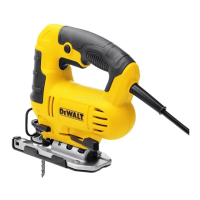8
ENGLISH
Protecting the Environment
w
Separate collection. Products marked with this symbol
must not be disposed of with normal householdwaste.
Products contain materials that can be recovered
or recycled reducing the demand for raw materials.
Please recycle electrical products according to local provisions.
Further information is available at www.2helpU.com.
Optional Accessories
WARNING: Since accessories, other than those offered
by
, have not been tested with this product, use
of such accessories with this tool could be hazardous.
To reduce the risk of injury, only
recommended
accessories should be used with thisproduct.
Consult your dealer for further information on the
appropriateaccessories.
D
Cleaning
WARNING: Blow dirt and dust out of the main housing
with dry air as often as dirt is seen collecting in and around
the air vents. Wear approved eye protection and approved
dust mask when performing thisprocedure.
WARNING: Never use solvents or other harsh chemicals
for cleaning the non‑metallic parts of the tool. These
chemicals may weaken the materials used in these parts.
Use a cloth dampened only with water and mild soap.
Never let any liquid get inside the tool; never immerse any
part of the tool into aliquid.
C
Lubrication
Your power tool requires no additionallubrication.
MAINTENANCE
Your power tool has been designed to operate over a long
period of time with a minimum of maintenance. Continuous
satisfactory operation depends upon proper tool care and
regularcleaning.
WARNING: To reduce the risk of serious personal
injury, turn tool off and disconnect tool from power
source before making any adjustments or removing/
installing attachments or accessories. An accidental
start‑up can causeinjury.
a small nail through hole in fence arm. Using rip fence as a pivot
arm, begin cutting circle. For circle cutting, the cross bar should
beup.
Rip/Circle Cutting (Fig.G, H)
Ripping and circle cutting without a pencil line is easily done
with the rip fence / circle guide (not included; available at
extracost).
Using the screw supplied with the accessory guide, position and
thread the screw into the shoe to clamp the fencesecurely.
When ripping, slide the rip fence under the screw from either
side of the saw. Set the cross bar at desired distance from blade
and tighten screw. For ripping, the cross bar should be down
and against the straight edge of theworkpiece.
When circle cutting, adjust rip fence so that distance from blade
to hole in fence arm is at the desired radius and tighten screw.
Place saw so that hole in fence arm is over centre of circle to be
cut (drill hole for blade or cut inward from edge of material to
get blade into position). When saw is properly positioned, drive
Hints for Optimum Use
Sawing laminates
• As the saw blade cuts on the upward stroke, splintering may
occur on the surface closest to the shoeplate.
• Use a fine‑tooth sawblade.
• Saw from the back surface of theworkpiece.
• To minimize splintering, clamp a piece of scrap wood or
hardboard to both sides of the workpiece and saw through
thissandwich.
Sawing metal
• Be aware that sawing metal takes much more time than
sawingwood.
• Use a saw blade suitable for sawingmetal.
• When cutting thin metal, clamp a piece of scrap wood to the
back surface of the workpiece and cut through thissandwich.
• Spread a film of oil along the intended line of cut for easier
operation and longer blade life. For cutting aluminum,
kerosene ispreferred.
Removable Shoe Sleeve (Fig.F)
The non‑marring shoe sleeve
5
should be used when cutting
surfaces that scratch easily, such as laminate, veneer, or
paint. It can also be used to protect the shoe surface during
transportation andstorage.
To attach shoe sleeve, place the front of the shoe
6
into the
front of the shoe sleeve and lower the jig saw as shown in
FigureF. The shoe sleeve will click securely onto the rear of
theshoe.
To remove shoe sleeve, grasp the sleeve from the bottom at the
two rear tabs and pull down and away from theshoe.
Setting the Pendulum Stroke
1. Move the pendulum stroke selectorr
9
between the four
cutting positions: 0, 1, 2, and3.
2. Position 0is straightcutting.
3. Positions 1, 2, and 3are orbitalcutting.
The aggressiveness of the cut increases as the lever is adjusted
from one to three, with three being the most aggressivecut.

